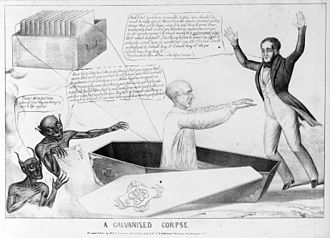Frankenstein: Difference between revisions
mNo edit summary |
|||
| Line 26: | Line 26: | ||
=== Galvanism === | === Galvanism === | ||
[[File:A Galvanised Corpse.jpg|thumb|Cartoon of a galvanized corpse (1836)]] | |||
* Benjamin Franklin's discoveries in the mid-1700s of the nature of lightning as electricity spurred research into electricity | * Benjamin Franklin's discoveries in the mid-1700s of the nature of lightning as electricity spurred research into electricity | ||
* in the late 1700s, Luigi Galvani realized that muscle tissue reacted to electricity | * in the late 1700s, Luigi Galvani realized that muscle tissue reacted to electricity | ||
| Line 33: | Line 33: | ||
** he proposed that electricity animated living things | ** he proposed that electricity animated living things | ||
** he called it "animal electricity" | ** he called it "animal electricity" | ||
*** became known as "Galvanism" | *** became known as "Galvanism" | ||
** became a cultural phenomenon (meme) | |||
*** cartoons and stories of corpses raised from the dead with electricity | *** cartoons and stories of corpses raised from the dead with electricity | ||
** the term "Galvanism" was actually coined by Alessandro Volta, who built the first chemical electric battery | ** the term "Galvanism" was actually coined by Alessandro Volta, who built the first chemical electric battery | ||
Revision as of 00:02, 12 April 2023
Frankenstein, a novel by Mary Shelley, 1818
- also called The Modern Prometheus
Mary Shelley[edit | edit source]
- her mother was the famed writer and women's rights thinker, '''Mary Wollenstonecraft'''
- Wollenstonecraft is considered the "first feminist"
- her father, '''William Godwin''', was a famous political philosopher and novelist
- Godwin was considered a political radical for his attacks on institutions, "aristocratic privilege", and religion
- he argued
- he was an early promoter of "utilitarianism," a philosophy that sought to create the "greatest good" or "happiness" for the "greatest number of people"
- Godwin wrote a novel that drew from John Milton's "Paradise Lost"
- Mary Shelley also drew inspiration from ''Paradise Lost''
- Godwin was considered a political radical for his attacks on institutions, "aristocratic privilege", and religion
- Shelley had an affair with the poet Percy Shelley, who was married, and married him in 1816
Writing of Frankenstein[edit | edit source]
- it was on a trip to Switzerland in 1816 w/ Shelley, the poet Lord Byron, and William Polidor that Mary Shelley wrote Frankenstein
The Summer with no Sun[edit | edit source]
- Mary wrote of her time in Switzerland,
"It proved a wet, ungenial summer, and incessant rain often confined us for days to the house"
Galvanism[edit | edit source]

- Benjamin Franklin's discoveries in the mid-1700s of the nature of lightning as electricity spurred research into electricity
- in the late 1700s, Luigi Galvani realized that muscle tissue reacted to electricity
- his assistant accidently touched a dead frog's leg with a charged scalpel, which made its leg move
- Galvani later realized that electricity produced the same effect
- he proposed that electricity animated living things
- he called it "animal electricity"
- became known as "Galvanism"
- became a cultural phenomenon (meme)
- cartoons and stories of corpses raised from the dead with electricity
- the term "Galvanism" was actually coined by Alessandro Volta, who built the first chemical electric battery
- for Volta, "Galvanism" referred to generation of electricity via chemical reactions